Carnegie Library - Weston

Address: 2 King Street, Weston
Architect: Lindsay & Brydon
Opened: 1914, December 29
The Weston Public Library Board was awarded $10,000 from the Carnegie Corporation of New York on January 2, 1913. Lindsay & Brydon, a Toronto architectural firm, designed a simple Arts and Crafts style library, enriched by stained-glass windows and Art Nouveau mosaic panels - a unique feature among the Ontario Carnegie libraries. The Weston Library opened on Tuesday evening, December 29, 1914 at the northwest corner of King and Main streets, Weston.
Weston Branch history panel (2014) (PDF)
Major Alterations
1981-2 Renovation and addition by Dunlop, Farrow & Aitken Architects. Officially reopened, September 11 1982.
Heritage Status
1978 Designation bylaw (2971-78) passed by York City Council under the Ontario Heritage Act, April 24.
History
Carnegie Library - Weston, 1909
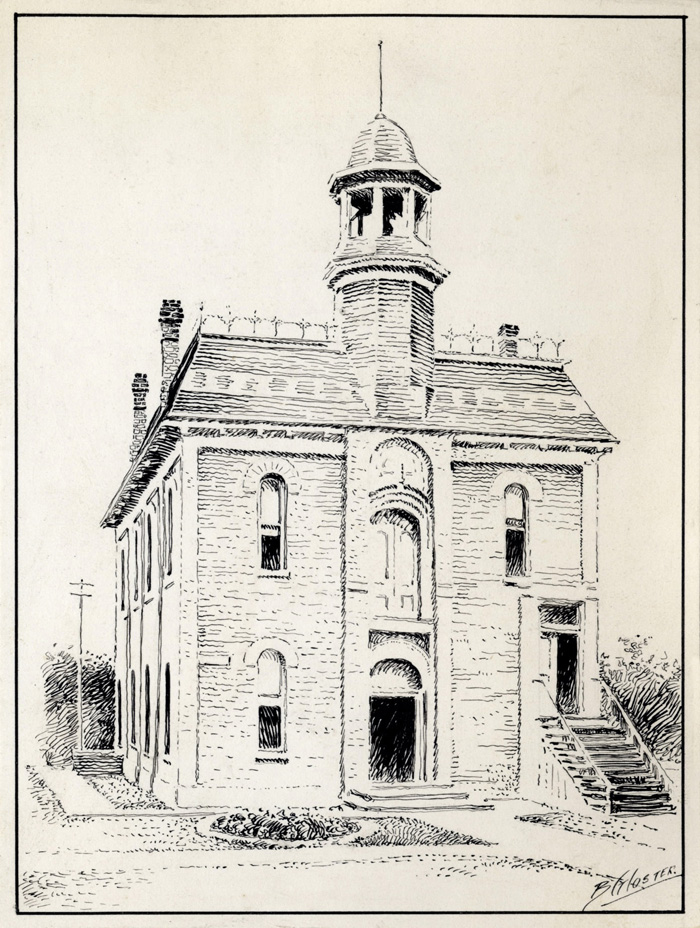 Weston Town Hall, 1909
Weston Town Hall, 1909Bernard Gloster/Toronto Reference Library. Canadian Historical Picture Collection B 5-7b
Library service was provided for 30 years in one or two back rooms in Weston Town Hall, first from 1884 to April 1895 by the Weston Mechanics' Institute (established in 1858) and then from May 1895 until December 1914 by the successor Weston Public Library. The building, also known as Dufferin Hall, stood at the northwest corner of today's Weston Road and Little Avenue, 1883-1957.
Weston's library service went back to the mid-1840s, though. Its first library was well underway by January 1847 when it was briefly mentioned in the British American Cultivator: "We are delighted to learn that the Village of Weston Library is producing happy results in that flourishing neighbourhood, and hope that similar institutions will be organized in every village in the Province, before the lapse of the present winter."1
On February 8, 1858, the Weston Mechanics' Institute was established to provide continuing education and a library for workers. The library was located in the Weston Plank Road home of James Cruickshank, Senior (1830-1916), a wagon and carriage maker, who served as Weston's first librarian.
Weston Mechanics' Institute disappeared from the public record in the 1860s and did not resurface until it was included in plans that architect and builder William Tyrrell completed on August 1, 1883 for a "Public Hall and Mechanics' Institute to be erected in Weston by the Council Thereof". (Tyrrell was also the first reeve of Weston, which was incorporated as a village in 1881). In 1884, the Institute opened in a 28- by 15-foot room at the back of the ground floor of Weston Town Hall; it was allocated a second, adjacent room in 1886.
A decade later, the Catalogue of books in the library of the Weston Mechanics' Institute listed 1,744 titles (a huge increase from the library's collection of 161 books in 1885), and declared that the Library was "Open every Tuesday and Saturday evening from 7 to 9" and the Reading Room "every evening from 7 to 10".
In 1895, provincial legislation changed Weston Mechanics' Institute to Weston Public Library. It was a "not free" public library, supported by members' fees and government grants, but not by the taxes of all local ratepayers. Another Public Library Act in 1909 changed the designation to Weston Public Library Association, but its "not free" status remained.
Weston Public Library became a free public library in January 1912, as part of the village's initiative to obtain a Carnegie grant to construct a library building, which opened on December 29, 1914.
Carnegie Library - Weston, 1914
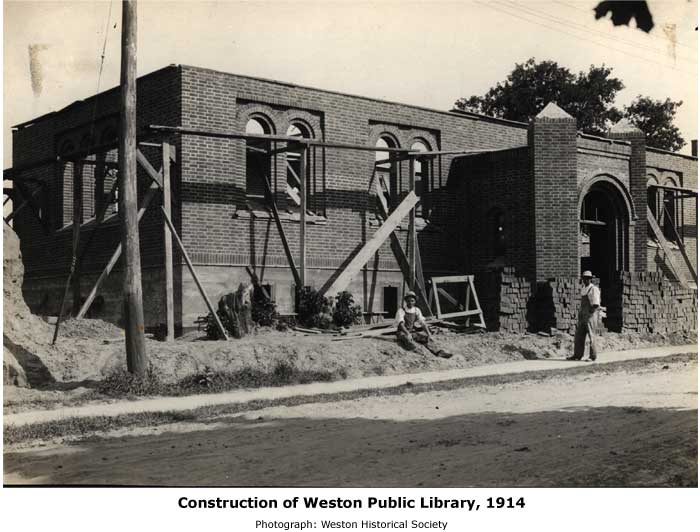
On January 2, 1913, the Village of Weston was awarded $10,000 from the Carnegie Corporation of New York "to erect a Free Public Library Bilding [sic] for WESTON". The previous year, a majority of Weston voters had agreed to change the "not free" Weston Public Library Association to a "free" public library, and to accept the other conditions of the Carnegie grant: the village would provide the building site and support by taxation no less than 10 percent the cost of the building for annual maintenance (books and staff).
Building plans were approved by James Bertram, secretary of the Carnegie Corporation, on August 5, 1913. The site, with a frontage of 60 feet on Weston Road by 140 feet on King Street, was acquired in two parcels: the larger one from David Rowntree Junior for $1300 and the smaller one from Elizabeth Aiken for $650. The purchases were registered on August 15, 1913.
Excavation for the building began on April 8, 1914 and by July the walls were almost ready for the roof. On August 15, 1914, the Toronto Star reported, "the new $10,000 free library at Weston is nearly completed, and should be ready to receive the books within a month."1 Nevertheless, the library did not officially open until December 29, 1914.
The prime consultants were Lindsay & Brydon, Architects (Peter White Lindsay was a Weston resident); George Sainsbury, Builder and Contractor (his business was on Coulter Avenue, Weston); Robert McCausland Limited, (stained glass windows); Italian Mosaic and Marble Company of Canada, Limited (mosaics over the front entrance and in the window spandrels); Sanitary Floor Co.; Kent-McClain Ltd. (book cases) and F. C. Henderson (electric lighting). All were Toronto or Weston companies. The architects charged fees of 5 percent on the $10,000 building, but gave the Library Board "a donation amounting to one percent of the cost of the completed Library Building."2
1"Suburban notes," Toronto Star, 19 August 1914, 11.
2Lindsay & Brydon to Joseph Nason, 9 September 1913. Weston Historical Society.
Carnegie Library - Weston, 1915
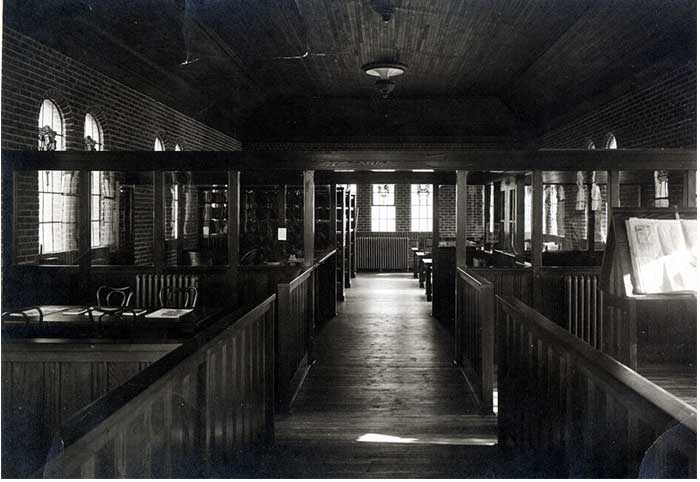 General Reading/Newspaper Room and Library, looking west, 1915?
General Reading/Newspaper Room and Library, looking west, 1915?
When it first opened, Weston Public Library's main floor housed the general reading/newspaper room and library (fitted with book stacks) in the west wing, the children's and ladies' departments in the east wing and the librarian's room in the centre directly behind the entrance. The wood ceiling shown here was replaced with a suspended acoustic ceiling in a 1962 renovation.
Originally a lecture room, the board room and two washrooms were in the basement; later the children's department was relocated there.
By the end of 1915, its first year of operation in the new building, the Weston Public Library served the town's 2,186 residents with a collection of 4,040 volumes that circulated 14,508 times. It also subscribed to 30 magazines and newspapers – some were stored on the racks visible here on the lower right.
The Weston Public Library opened on Tuesday, December 29, 1914. Two days later, a local newspaper published this enthusiastic report:
The formal opening of the Weston Carnegie Library building took place on Tuesday night. The new building recently completed is a fine specimen of architecture and a splendid tribute to the untiring energy and perseverance of the Board of Directors. A person entering the building is impressed with the idea that the Board has left nothing undone to make for the comfort and convenience of patrons and visitors. The lights are restful to the eye and seem to the casual observer to be all that can be desired.1
The Weston Public Library Board in 1914 was comprised of Joseph Nason (Chairman), W. J. Bourke (Secretary), Levi H. Mercer (Treasurer), A. L. Campbell, John J. Dalton (Chairman of the Carnegie Committee), Dr. E. F. Irvin, Nelson J. McEwen, Thomas J. Maguire and Thomas Moore.
1 F.D. Cruickshank and J. Nason. History of Weston: 117-18.
Carnegie Library - Weston, 1916

Weston Public Library was planned by Peter White Lindsay (1886-1953), a Weston resident, who formed a partnership with Alexander MacKenzie Brydon (1881-1971) in 1912/13. Both men were originally from Scotland and had worked in architectural firms in Edinburgh before immigrating to Canada around 1907.
Lindsay & Brydon issued the first plans for the Weston library in February 1913 but their designs were not approved by the Carnegie Corporation of New York until August 1913. John W. D. Greig later joined the firm. Their collaboration was successful but brief; Lindsay Brydon & Greig was dissolved in 1915.
Weston Public Library was described by architect Donald G. Rankin in 1978 as "a well scaled building of warmth, charm, and considerable elegance, a tribute to the skill and resourcefulness of its designer."1 Said to have "been on the Spanish style with round arches over the windows,"2 the library features several Arts and Crafts style elements. The low-hanging hipped roof and deep eaves reinforces its connection with the site. The double entrance doors are framed by two large offset pilasters and crowned with large arches of multiple recessed brickwork turned and shaped to add more detail.
George Sainsbury (1875-1951), a Weston contractor and builder, was responsible for constructing the library. "The brick chases, recesses, curved heads, sloping sills, and other features, required both skill and time in their execution," Rankin noted. The red bricks were manufactured from clay mined at the John Price brickworks (located on Greenwood Avenue, Toronto) and formed in wooden molds. "The manufacturing process," Rankin added, "produced bricks that were not completely uniform but slightly warped, contributing to the warmth and character of the brickwork."2
Weston Public Library was designated a heritage building on April 24, 1978. A historical plaque about the library was dedicated in 1979 by the Borough of York and the Ontario Ministry of Culture and Recreation.
1 "Donald J. Rankin, "Commentary: Weston Public Library," Unpublished paper, 2 March 1978. Weston Historical Society
2 Weston's new library; it will be in Spanish Style and will cost $10,000," Toronto Daily Star, April 17, 1914, 9.
3 Rankin, "Commentary," 1978.
Carnegie Library - Weston, 1955

Library service began at Weston on February 8, 1858 when the Weston Mechanics' Institute was incorporated, receiving a grant of $140 from the provincial government. Members paid an annual fee to use its library, located on Main Street (Weston Road) in the home of the librarian, James Cruickshank, a local wagon maker, undertaker and justice of the peace.
In 1885, the Weston Mechanics' Institute was revitalized (the book collection had been stored in the John Hathaway Banks's drug store, Main Street), reorganized and relocated to two rooms in the rear of the new Weston Town Hall, completed that year at the northwest corner of Main Street and Little Avenue.
This handsome building, situated in the centre of the village, was erected in 1883. It was two stories in height, and on the ground floor were the municipal offices, the council chamber and the Mechanics' Institute, predecessor of the Public Library. The second floor was occupied entirely by the spacious Dufferin Hall ... the scene of many concerts and other entertainments. Many of the outstanding political figures of the last century were heard in this hall.1
Local citizens donated books and raised funds for the library, which was open two evenings a week. In 1888, evening classes in bookkeeping and other subjects were taught at the Institute. In 1909, a children's department was established and the collection of 2,809 adult and 465 juvenile books was catalogued and classified by the official cataloguer with the Ontario Inspector of Public Libraries.
A board of management operated the Weston Mechanics' Institute. It held annual elections to appoint a chairman, a secretary, a treasurer and a librarian. In May 1909, library officials approached the Village of Weston Council about applying for a Carnegie grant to build a library. The original Weston Town Hall was demolished in 1957.
1F. D. Cruickshank and J. Nason. History of Weston. Originally printed by The Times and Guide, Weston, Ontario, 1937. Toronto: Weston Historical Society, 1983, 25-6.
Carnegie Library - Weston, 1982
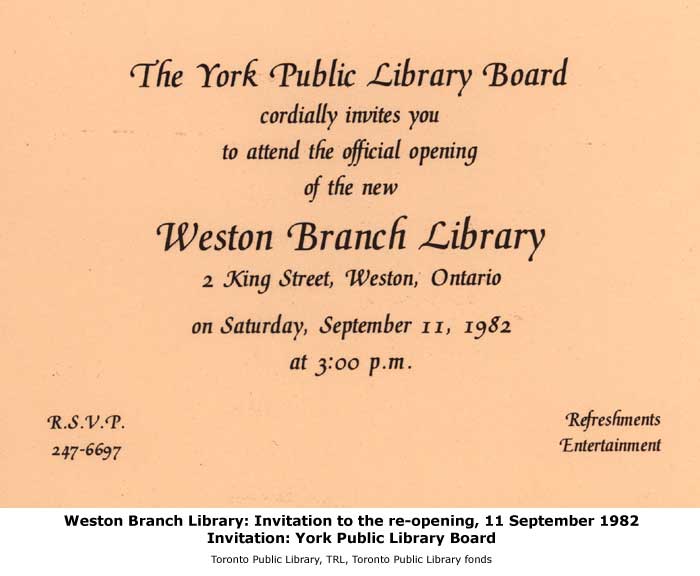
Over time, Weston Public Library became outdated and overcrowded. A renovation in 1962 by Dunlop, Wardell, Matsui, Aitken, Architects included a redesigned foyer and circulation desk, and a suspended acoustic ceiling and fluorescent lighting in the main room.
Occupying approximately 4,200 square feet, with a frontage of 70 feet and a depth of 30 feet on each floor, the library was "roughly the same size as a typical suburban bungalow including its two-car garage," Rankin observed in 1978.
When plans to relocate the library to a new site were met with community opposition, it was decided to renovate and extend the original building instead. Dunlop, Farrow & Aitken Architects designed a renovation and an addition, almost tripling the size of the original building to 11,944 sq. ft. (1,111 sq. m.). The work was planned for the 100th anniversary of the incorporation of Weston in 1981. The library officially reopened on September 11, 1982.
The Weston Public Library Board had been taken over by the Borough of York Public Library Board in 1967, when the Town of Weston became part of the Borough of York. The York Public Library Board in 1982 was comprised of Frank Lambert (chairman), C. Douglas Cuthbert (vice-chariman), Fergy Brown (mayor's representative), Alberto DiGiovanni, Josef Galambosy, Ian McGeachan, James Pole-Langdon, F. Roy Rutherford, Harriet Wolman and Bohus Derer (director and secretary treasurer).
Carnegie Library - Weston, 2004
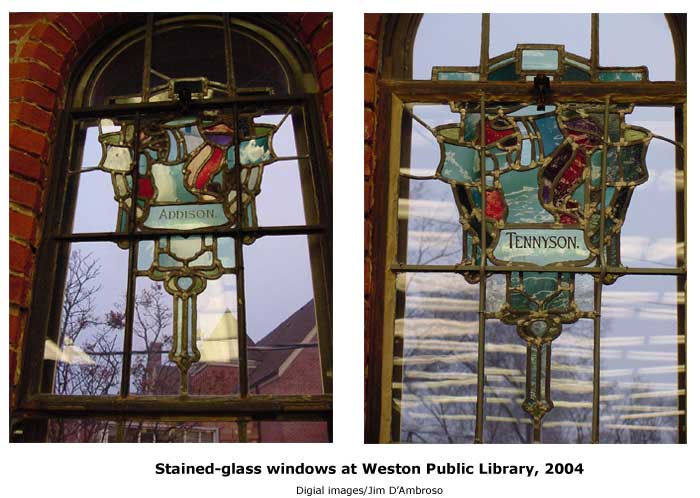
In 1914, Robert McCausland Limited created 24 stained-glass windows for the four exterior walls of the new Weston Public Library. Each window was decorated with a crest and a banner. Twenty-three of the banners were inscribed with the name of a prominent author of the time, while one banner was left mysteriously blank. The firm was paid $715 for its work.
Born in Toronto in 1856, Robert McCausland was the eldest son of Joseph McCausland (1828-1905), a painter, a decorator, and a designer and manufacturer of stained-glass windows, who had started as a practicing artisan at age 11. Robert became a partner in his father's firm in 1881. Occupying four buildings on King Street West, Joseph McCausland and Son had from 70 to 100 employees. Its work in Toronto include windows in many churches, residences and the Ontario Legislative Buildings as well as the opulent skylight at the Bank of Montreal (now the Hockey Hall of Fame).
The stained-glass department of the McCausland firm was made a separate company under Robert in 1897. The first commission to come to him on his own (and the best-known McCausland work) was the large window on the stairs opposite the entrance in Toronto's third City Hall.
Robert McCausland died in 1923, but his firm continues to operate, claiming in 2014 that "Robert McCausland Limited is the oldest stained glass company in the Western Hemisphere. ... also the longest, continuously owned family company in Canada."
"Stained glass was used in several of the early Carnegie libraries to add an air of quality to the appearance;" claim the authors of The Best Gift; a record of the Carnegie libraries in Ontario, "the libraries at Guelph, Chatham, and Ottawa, for example, were enriched in this way." Authors' names were inscribed on a few other Carnegie-funded libraries in Ontario, they also note. "The Brantford window heads with display of authors' names were matched in the Fort William Library, where the busts of similar authors were depicted in the stained glass window heads on three sides of the building."
Carnegie Library - Weston, 2004 - Front
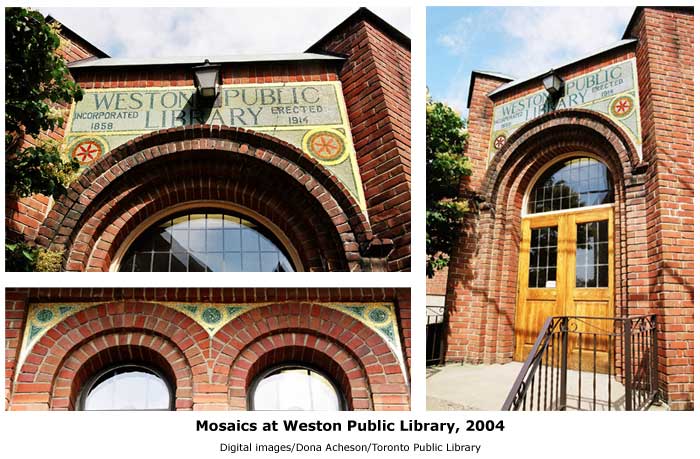
"The simplicity of design in the Weston Library is enriched by Art Nouveau mosaic panels over the windows and main entrance, a unique feature among Ontario's Carnegie libraries," noted the authors of The Best Gift; a record of the Carnegie libraries in Ontario Architect Donald J. Rankin observed in 1978, "From certain angles at night, this mosaic work reflects the street lights with an almost Byzantine effect."
The mosaics over the original front entrance and in the window spandrels were created by The Italian Mosaic and Marble Company of Canada, Limited which was paid $500 for its work. The company was owned by an American family originally from the Fruili region of Italy. Details about the De Spirts operations are provided in John E. Zucchi's history, Italians in Toronto:
In the late 1890s, a fruilano family originally from Fanna, the De Spirts, moved from New York City to Buffalo where they opened a mosaic, marble, and terrazzo firm. From Buffalo, employees were sent to various worksites in the American west and midwest ... In 1912, Albino Pedron was sent to Toronto by the De Spirt family to work at one of its jobsites and to open a branch office from which he could expand into the Canadian market. Pedron seized the opportunity to establish his own business and the De Spirts had to send one of their own sons to complete with their former employee and with some of the older Canadian firms which had been hiring fruilani mosaic, marble, and terrazzo workers, and tile setters.
Attilio Charles De Spirt (1897-1970) was the son that was sent from Buffalo, but he was not a Toronto resident at least until September 1918, when his registration papers for the United States draft stated that the 21-year-old American was the manager of the Italian Mosaic & Marble Co., located in the Crown Tailoring Building at the corner of College and Euclid, and lived at 44 Berwick Avenue.
Prior to Attilio's arrival, Toronto city directories show that the Italian Mosaic and Marble Company of Canada was managed first by Victor T. Goggin (born in Winnipeg in 1888 and working as a salesman for a mosaic company in Boston by 1917) and then by Joseph P. Connolly. "A. C. De Spirt" was not listed as the company's manager until the 1921 city directory, and the business then was located at 442 King Street West, just east of Spadina Avenue.
 Advertisement for the Italian Mosaic and Marble Company, 1915
Advertisement for the Italian Mosaic and Marble Company, 1915
The company dominated the trade by that time. In the early 1920s, it opened an office in London, Ontario and was featured on full-page spreads in several building and engineering catalogues, which detailed the company's activities and provided a "Partial list of Buildings in which the Italian Mosaic and Marble Co. of Canada, Ltd., have executed designs and work." Among the dozens of references in the 1924 catalogue was one for "Public Library, Weston, Ont." and another for "Knox Presbyterian Church, Stratford, Ont.", both planned around 1913-14 by Lindsay & Brydon Architects.
In 1925, Egidio (Gid/Giles) De Spirt (1894-1981) moved to Toronto to replace his younger brother, who went back to Buffalo to take over the family business there. Egidio continued the predominance of the Canadian branch. Under his management, the Italian Mosaic and Marble Company of Canada supplied the terrazzo and marble to the Empire Hotel in North Bay (1927), for example, and created the mosaic ceiling at the Royal Ontario Museum (1933). Egidio De Spirt remained in Toronto, and is buried in Mount Hope Cemetery.




